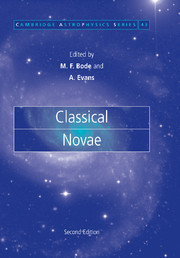Book contents
- Frontmatter
- Contents
- List of contributors
- Preface to the first edition
- Preface to the second edition
- List of symbols
- 1 Novae: an historical perspective
- 2 Properties of novae: an overview
- 3 The evolution of nova-producing binary stars
- 4 Thermonuclear processes
- 5 Nova atmospheres and winds
- 6 Observational mysteries and theoretical challenges for abundance studies
- 7 Radio emission from novae
- 8 Infrared studies of classical novae
- 9 Optical and ultraviolet evolution
- 10 X-ray emission from classical novae in outburst
- 11 Gamma-rays from classical novae
- 12 Resolved nebular remnants
- 13 Dust and molecules in nova environments
- 14 Extragalactic novae
- Object index
- Subject index
7 - Radio emission from novae
Published online by Cambridge University Press: 10 October 2009
- Frontmatter
- Contents
- List of contributors
- Preface to the first edition
- Preface to the second edition
- List of symbols
- 1 Novae: an historical perspective
- 2 Properties of novae: an overview
- 3 The evolution of nova-producing binary stars
- 4 Thermonuclear processes
- 5 Nova atmospheres and winds
- 6 Observational mysteries and theoretical challenges for abundance studies
- 7 Radio emission from novae
- 8 Infrared studies of classical novae
- 9 Optical and ultraviolet evolution
- 10 X-ray emission from classical novae in outburst
- 11 Gamma-rays from classical novae
- 12 Resolved nebular remnants
- 13 Dust and molecules in nova environments
- 14 Extragalactic novae
- Object index
- Subject index
Summary
Introduction
In this chapter, we review the observation of radio emission from classical novae. In the majority of cases such emission is undoubtedly dominated by that from the thermal bremsstrahlung process and we begin by giving an overview of such emission arising from relatively simple geometries. We then move on to describe various models of the kinematics in novae and show how these have been combined with the thermal emission process described earlier to fit the radio light curves of several well-observed novae. However, it has become apparent that relatively simple spherically symmetric models fail to describe some of the details in the observations of more recent objects and more complex modelling is introduced. This is reinforced when we consider the evolution of the resolved radio remnants as illustrated in Chapter 12.
In the first edition of this book in 1989, radio emission was reported to have been detected in nine classical novae and, of these, two were spatially resolved (Seaquist, 1989). Since then, we have seen the advent of improvements to the sensitivity of radio arrays. Here we consider observations of radio emission from a total of eighteen classical novae, and as reported here and in Chapter 12, at least six of these have published radio imagery.
- Type
- Chapter
- Information
- Classical Novae , pp. 141 - 166Publisher: Cambridge University PressPrint publication year: 2008
- 14
- Cited by



